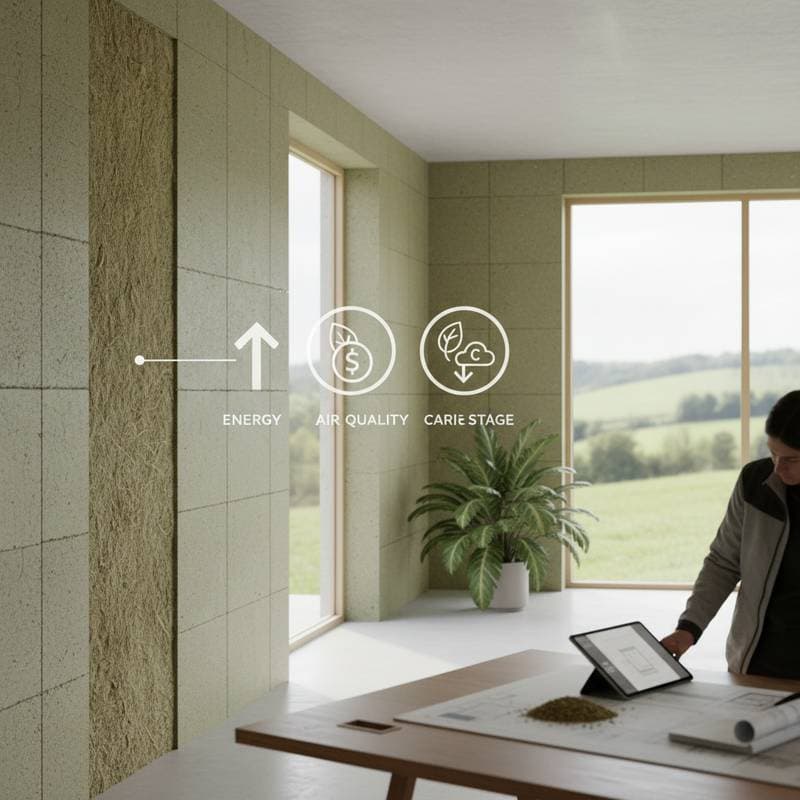Mycelium and Hemp: Pioneering Sustainable Homes by 2025
Picture the home of the future equipped with solar panels and smart technology. The true innovation lies in materials derived from nature. Mycelium, the root-like network of mushrooms, and hemp composites lead this shift, enabling builders to grow rather than manufacture essential components for insulation and structure.
These materials address key environmental concerns in construction. Traditional methods rely on resource-intensive concrete and plastics, which contribute significantly to global emissions. Mycelium and hemp offer renewable alternatives that sequester carbon during growth, fostering a cycle of sustainability.
Essential Properties
Mycelium and hemp serve as direct replacements for concrete, plastics, and synthetic insulators. Structures incorporating them achieve carbon emission reductions of up to 60 percent relative to standard builds. Mycelium forms lightweight panels that resist fire and decompose fully at end of life.
Hempcrete, composed of hemp hurds and lime, excels in thermal regulation and moisture management. This combination produces homes that breathe naturally, promoting energy efficiency and occupant health. Builders select these options for their alignment with long-term ecological goals.
Integrating Mycelium with Hemp
Mycelium binds to hemp fibers, forming a robust bio-composite. This synergy enhances strength while maintaining flexibility in design. The resulting panels provide superior sound absorption, consistent temperature control, and complete biodegradability.
Research from green architecture teams reveals that mycelium-hemp composites reach a thermal conductivity of 0.03 W/mK. This value surpasses the 0.04 W/mK typical of fiberglass. Such performance positions these materials as top choices for natural insulation.
Production benefits from this pairing as well. Hemp offers a stable base for mycelium colonization, accelerating panel creation. This efficiency lowers timelines for builders and delivers high-quality results for residents seeking durable, eco-friendly solutions.
Material Property Comparison
| Property | Mycelium | Hempcrete | Mycelium-Hemp Composite |
|---|---|---|---|
| Thermal Conductivity (W/mK) | 0.04 | 0.05 | 0.03 |
| Fire Resistance | High | Moderate | High |
| Moisture Regulation | Excellent | Excellent | Excellent |
| Weight | Very Light | Medium | Light |
| End-of-Life Disposal | Fully Biodegradable | Recyclable | Fully Biodegradable |
Practical Implementations and Pioneers
Professionals in architecture test these materials through targeted projects. Compact residences and modular assemblies using mycelium panels alongside hempcrete walls demonstrate energy reductions of up to 50 percent over traditional counterparts. These setups thrive in regions with variable weather, where effective insulation proves essential.
Developers advance prefabricated systems that integrate hemp with mycelium. Such panels arrive onsite ready for assembly, minimizing equipment needs and waste. This method supports broader adoption by simplifying logistics and cutting expenses.
A specialist in sustainable building notes, "The goal is not to make nature fit our processes but to let our processes fit nature." This mindset fuels progress in bio-architecture, emphasizing cultivation over extraction.
Evaluating Costs, Access, and Returns
Homeowners often inquire about expenses. Mycelium and hemp currently demand 10 to 25 percent more in initial outlay than conventional options. Over time, benefits like decreased energy use and minimal upkeep recover these costs effectively.
One cooperative's analysis shows homes with these materials saving 35 percent on yearly energy bills. Payback occurs in seven to ten years, bolstered by the absence of toxic disposal fees. Non-toxic composition further enhances indoor air quality.
Supportive policies emerge regionally. Tax incentives and reduced permitting fees reward bio-based projects. As regulations evolve, these measures encourage wider use of sustainable alternatives.
Addressing Hurdles and Research Advances
Scaling presents obstacles, including mycelium's need for precise cultivation environments and hemp's regulatory limits in certain areas. Efforts focus on standardizing quality, boosting longevity, and aligning with international codes.
Perception issues persist, with some viewing these as unproven. Targeted education and data sharing counter this through pilot showcases and collaborative testing. Confidence grows among professionals as evidence accumulates.
Ongoing studies optimize fungal strains for rapid, resilient growth. Hemp breeding targets enhanced fiber output with less water. These developments promise greater availability and lower prices soon.
Experiencing Bio-Based Residences
Residents in mycelium and hemp homes gain environmental and personal advantages. Breathable walls maintain fresh air circulation, while insulation ensures steady comfort across seasons. Organic construction often fosters a serene atmosphere, free from synthetic odors and echoes.
Upkeep remains simple. These surfaces deter mold and insects inherently. Repairs involve matching biodegradable fillers, preserving integrity without specialized tools.
Design versatility adds appeal. Textures and colors integrate seamlessly with contemporary styles, offering warmth alongside functionality.
Steps to Adopt Sustainable Materials
Incorporate mycelium and hemp without major disruptions. Begin by swapping insulation for hemp variants in attics or walls. Experiment with mycelium panels for partitions or built-ins to test performance.
Consult local experts for integration advice tailored to your climate. Track energy metrics post-installation to quantify gains. Each step builds toward a resilient, lower-impact living space.









